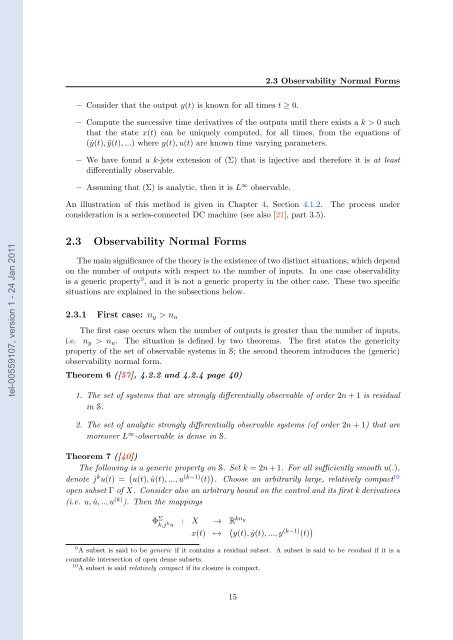Adaptative high-gain extended Kalman filter and applications
Adaptative high-gain extended Kalman filter and applications
Adaptative high-gain extended Kalman filter and applications
You also want an ePaper? Increase the reach of your titles
YUMPU automatically turns print PDFs into web optimized ePapers that Google loves.
tel-00559107, version 1 - 24 Jan 2011<br />
− Consider that the output y(t) is known for all times t ≥ 0.<br />
2.3 Observability Normal Forms<br />
− Compute the successive time derivatives of the outputs until there exists a k>0 such<br />
that the state x(t) can be uniquely computed, for all times, from the equations of<br />
(˙y(t), ¨y(t), ...) where y(t),u(t) are known time varying parameters.<br />
− We have found a k-jets extension of (Σ) that is injective <strong>and</strong> therefore it is at least<br />
differentially observable.<br />
− Assuming that (Σ) is analytic, then it is L ∞ observable.<br />
An illustration of this method is given in Chapter 4, Section 4.1.2. The process under<br />
consideration is a series-connected DC machine (see also [21], part 3.5).<br />
2.3 Observability Normal Forms<br />
The main significance of the theory is the existence of two distinct situations, which depend<br />
on the number of outputs with respect to the number of inputs. In one case observability<br />
is a generic property 9 , <strong>and</strong> it is not a generic property in the other case. These two specific<br />
situations are explained in the subsections below.<br />
2.3.1 First case: ny >nu<br />
The first case occurs when the number of outputs is greater than the number of inputs,<br />
i.e. ny >nu. The situation is defined by two theorems. The first states the genericity<br />
property of the set of observable systems in S; the second theorem introduces the (generic)<br />
observability normal form.<br />
Theorem 6 ([57], 4.2.2 <strong>and</strong> 4.2.4 page 40)<br />
1. The set of systems that are strongly differentially observable of order 2n +1 is residual<br />
in S.<br />
2. The set of analytic strongly differentially observable systems (of order 2n +1) that are<br />
moreover L ∞ -observable is dense in S.<br />
Theorem 7 ([40])<br />
The following is a generic property on S. Set k =2n +1. For all sufficiently smooth u(.),<br />
denote j k u(t) = � u(t), ˙u(t), ..., u (k−1) (t) � . Choose an arbitrarily large, relatively compact 10<br />
open subset Γ of X. Consider also an arbitrary bound on the control <strong>and</strong> its first k derivatives<br />
(i.e. u, ˙u, .., u (k) ). Then the mappings<br />
Φ Σ<br />
k,j k u : X → R kny<br />
x(t) ↦→ � y(t), ˙y(t), ..., y (k−1) (t) �<br />
9 A subset is said to be generic if it contains a residual subset. A subset is said to be residual if it is a<br />
countable intersection of open dense subsets.<br />
10 A subset is said relatively compact if its closure is compact.<br />
15

















